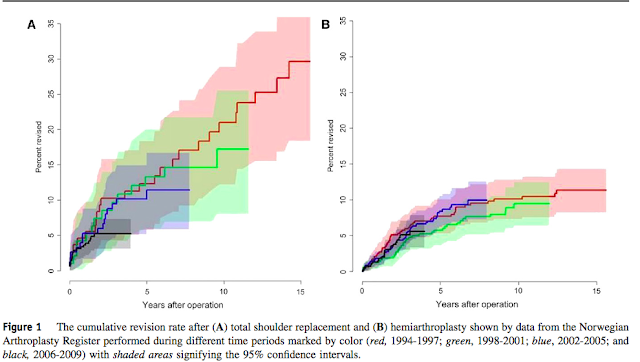A review of national shoulder and elbow joint replacement registries.
Between 1994 and 2004, 6 shoulder registries; by the end of 2009, the shoulder registries included between 2498 and 7113 replacements. The registries were initiated by orthopedic societies and funded by the government or by levies on implant manufacturers. In some countries, data reporting and patient consent are required. Completeness is assessed by comparing data with the national health authority. All registries use implant survival as the primary outcome. Some registries use patient-reported outcomes as a secondary outcome.
Data from national registries can cause us to re-think our approach. For example, many surgeons are convinced that total shoulder is superior to hemiarthroplasty, but the Finnish data on revision rates (see below) deserve consideration.
Emerging data from this collaboration enable comparison of survival rates among implants
Comment: Notably NOT on the list of countries with national registries are those performing the largest number of shoulder joint replacements: the United States, France, Germany and Switzerland. Imagine how much faster we'd learn about what was and what was not working if we followed the example of our Scandinavian and South Pacific colleagues. It is also of interest that the great preponderance of shoulder arthroplasty implants are made in the countries NOT participating in national registries. One would think that the wealth created by implant sales would easily support registries in these countries
===
Check out the new Shoulder Arthritis Book - click here.
Use the "Search" box to the right to find other topics of interest to you.
You may be interested in some of our most visited web pages including:shoulder arthritis, total shoulder, ream and run, reverse total shoulder, CTA arthroplasty, and rotator cuff surgery as well as the 'ream and run essentials'



